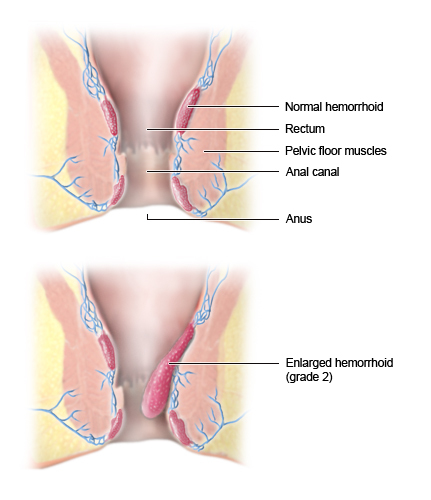NCBI Bookshelf. A service of the National Library of Medicine, National Institutes of Health.
InformedHealth.org [Internet]. Cologne, Germany: Institute for Quality and Efficiency in Health Care (IQWiG); 2006-.
Introduction
We all have hemorrhoids. Hemorrhoids are normal ring-shaped “cushions” of blood vessels and supporting tissue, found at the end of the rectum, just inside the anus. Together with a circular muscle called the anal sphincter, they help to close the rectum to the outside. This ensures that, for instance, the body releases only gas and not any solid matter when we pass wind (fart).
But when people talk about “having hemorrhoids,” they typically mean symptoms such as itching around their anus or bleeding during or after a bowel movement ("pooping"), which can be caused by enlarged hemorrhoids. This condition is also known as “piles.”
Many people are ashamed of having enlarged hemorrhoids: They don’t like to talk about their symptoms, and might be reluctant to go to the doctor. Some might be afraid of having a physical examination or finding out that they have a serious illness. But the symptoms are usually caused by something that is quite harmless. It is important to see a doctor about your symptoms if you want to have the right treatment.
At a glance
- Hemorrhoids are “cushions” of blood vessels and supporting tissue found at the end of the rectum, just inside the anus. We all have them.
- If hemorrhoids become enlarged, they can cause symptoms like bleeding, itching and burning around the anus.
- If the hemorrhoids are only slightly enlarged, doctors recommend changing your diet and bowel habits.
- There is no good-quality research on whether creams, suppositories or shallow warm baths (sitz baths) can help.
- If the hemorrhoids become very enlarged, surgery is usually needed.
Symptoms
Hemorrhoid problems can cause various symptoms, but the main one is painless bleeding during or after a bowel movement. This can happen if hard stool or pushing too hard damages the thin walls of the blood vessels in the hemorrhoids. Bleeding from hemorrhoids can usually be seen as bright red or red blood, on toilet paper or in the stool. If you have blood in your stool, it’s important to see a doctor rather than trying to diagnose the problem yourself.
The other typical symptoms affecting the area around the anus include:
- Itching
- Wetness
- Burning
- Unintentional release of small amounts of mucus and stool
- The feeling that you haven't emptied your bowels completely after you go to the toilet
- A feeling of pressure or that a foreign object is there
Enlarged hemorrhoids might come out of the anus and can then be seen as soft lumps of tissue. This is called a protruding or prolapsed hemorrhoid. Sometimes hemorrhoids are confused with anal skin tags, which are harmless flaps of skin on the anus that usually don't cause any symptoms.
Only very advanced hemorrhoids tend to cause pain. But the pain is often caused by other skin injuries near the anus, such as cracks in the skin.
Hemorrhoids can be classified into four groups, according to how severe they are:
- Grade 1: Slightly enlarged hemorrhoids that can’t be seen from outside the anus.
- Grade 2: Larger hemorrhoids that sometimes come out of the anus, for example while passing stool or – less commonly – during other physical activities. They then go back inside again on their own.
- Grade 3: Hemorrhoids that come out of the anus when you go to the toilet or do other physical activities, but don’t go back inside on their own. They can be pushed back inside, though.
- Grade 4: Hemorrhoids that are always outside the anus and can no longer be pushed back inside. Usually, a small bit of the anal lining comes out of the anus too. This is also known as rectal prolapse.

Hemorrhoid tissue, cross-section view: normal (above) and enlarged (below)
Causes and risk factors
There is not a lot of research on the causes and risk factors related to enlarged hemorrhoids. Studies have not led to any clear conclusions.
Hemorrhoids probably arise because the tissue that supports them becomes weaker over time. And hemorrhoid problems are thought to run in families too.
Other possible factors include:
- Chronic constipation
- Hard stool
- Straining during bowel movements
- Frequent diarrhea
- Being overweight
Prevalence
Enlarged hemorrhoids are very common: It is estimated that more than half of all adults are affected by this problem at some point in their lives. But a lot of people don't seek medical help. Every year, about 4 out of 100 adults in Germany go to a doctor because of hemorrhoid problems.
Outlook
It is not possible to predict how hemorrhoids will continue to develop over time. They might get worse and cause more severe symptoms. But they might not get bigger, and the symptoms might improve again. Hemorrhoids that are already enlarged usually don't get smaller on their own again, though.
If enlarged hemorrhoids start to leak fluid ("weep"), the skin in the anal region can also become irritated, which sometimes results in anal eczema. In anal eczema, the skin around the anus is red and inflamed, accompanied by itching and weeping. Small blisters and scabs might form as well.
Diagnosis
Some people are afraid of being examined in that part of their body, and worried that it will hurt. The examinations usually don't cause any pain, though. Some people find them uncomfortable or embarrassing. But they’re a normal part of everyday life for medical professionals.
When you go to see a doctor, you will probably first be asked about your symptoms and whether you have other medical conditions. The doctor will then look at your anus to see whether it is inflamed, and whether enlarged hemorrhoids come out of it when you push, or whether they are already outside. This is followed by a digital rectal examination, which involves gently inserting a finger into the anus, using gloves and a little lubricant. The doctor feels the inside of the anal canal. This allows him or her to examine the sphincter muscles and the texture of the membranes lining the anus. Grade 1 hemorrhoids generally can’t be felt in this way. But digital rectal examinations can help to rule out other medical conditions. The procedure is usually not painful.
If the doctor thinks you might have enlarged hemorrhoids, a proctoscopy is normally carried out next. Here the membranes lining the rectum (the last part of the bowel) are examined using a short tube with a light and camera on it, known as a proctoscope. This allows the doctor to see whether you have enlarged hemorrhoids, and how big they are. The procedure takes a few minutes and is usually not painful. The rectum needs to be emptied before the procedure is carried out. This can be done using a laxative, suppository or enema.
Depending on your symptoms, more examinations may follow. If there’s blood on your stool, the doctor may suggest a colonoscopy (looking inside your bowel with a camera).
Treatment
The choice of treatment will mainly depend on the size of the hemorrhoids and the severity of symptoms. If the hemorrhoids are only slightly enlarged, avoiding constipation and changing your behavior during bowel movements might be enough.
There’s a lot of advice out there about what you can do to relieve hemorrhoid symptoms yourself – like using creams or shallow warm baths (sitz baths), or changing your diet. Some of these treatments may relieve the symptoms for a while, but there isn't any good-quality research on many of them.
So it's a good idea to see a doctor if your symptoms are bothersome. You could contact your family doctor or a proctologist. Proctologists are doctors who are specialized in medical conditions affecting the rectum and anus.
You can discuss other possible treatments with them, for instance. There are various treatment options, depending on the severity of the symptoms.
- Sclerotherapy (for grades 1 and 2): This involves injecting a chemical solution to reduce the blood supply to the hemorrhoids.
- Rubber band ligation (for grade 2): The hemorrhoids are tied off at the base, making them fall off after a while.
- Surgery (for grade 3 or 4): If someone has grade 3 or grade 4 hemorrhoids, it might be necessary to surgically remove them. Various surgical procedures are used, depending on where the hemorrhoids are located and how far they stick out.
Further information
Hemorrhoids can usually be treated without having to stay at the hospital. But some types of treatment and surgery can only be performed at a hospital. It is worth preparing for a hospital stay: You can find out about what to expect, what documents you'll need in order to be admitted, and which procedures involve extra costs, for example.
Sources
- Abramowitz L, Weyandt GH, Havlickova B et al. The diagnosis and management of haemorrhoidal disease from a global perspective. Aliment Pharmacol Ther 2010; 31 (Suppl 1): 1-58. [PubMed: 20500735]
- Acheson AG, Scholefield JH. Management of haemorrhoids. BMJ 2008; 336(7640): 380-383. [PMC free article: PMC2244760] [PubMed: 18276714]
- Alexander K, Daniel WG, Diener HG et al. Thiemes Innere Medizin (TIM). Stuttgart: Thieme; 1999.
- Alonso-Coello P, Guyatt GH, Heels-Ansdell D et al. Laxatives for the treatment of hemorrhoids. Cochrane Database Syst Rev 2005; (4): CD004649. [PMC free article: PMC9036624] [PubMed: 16235372]
- Deutsche Gesellschaft für Koloproktologie (DGK). Hämorrhoidalleiden (S3-Leitlinie). AWMF-Registernr.: 081-007. 2019.
- Hahn EG, Riemann FJ. Klinische Gastroenterologie. Stuttgart: Thieme; 2000.
- Joos AK, Herold A. Hämorrhoidalleiden. Neue konservative und operative Therapien für ein weit verbreitetes Leiden. Der Gastroenterologe 2010; 5: 326-335.
- Klauber J, Geraedts M, Friedrich J et al. Krankenhaus-Report 2013. Mengendynamik: Mehr Menge, mehr Nutzen? Stuttgart: Schattauer; 2013.
- Lohsiriwat V. Hemorrhoids: from basic pathophysiology to clinical management. World J Gastroenterol 2012; 18(17): 2009-2017. [PMC free article: PMC3342598] [PubMed: 22563187]
- Mounsey AL, Halladay J, Sadiq TS. Hemorrhoids. Am Fam Physician 2011; 84(2): 204-210. [PubMed: 21766771]
- National Institute for Health and Care Excellence (NICE). Haemorrhoids. 2012.
- Ng KS, Holzgang M, Young C. Still a Case of "No Pain, No Gain"? An Updated and Critical Review of the Pathogenesis, Diagnosis, and Management Options for Hemorrhoids in 2020. Ann Coloproctol 2020; 36(3): 133-147. [PMC free article: PMC7392573] [PubMed: 32674545]
- Pschyrembel Online. 2021.
IQWiG health information is written with the aim of helping people understand the advantages and disadvantages of the main treatment options and health care services.
Because IQWiG is a German institute, some of the information provided here is specific to the German health care system. The suitability of any of the described options in an individual case can be determined by talking to a doctor. informedhealth.org can provide support for talks with doctors and other medical professionals, but cannot replace them. We do not offer individual consultations.
Our information is based on the results of good-quality studies. It is written by a team of health care professionals, scientists and editors, and reviewed by external experts. You can find a detailed description of how our health information is produced and updated in our methods.
- Overview: Enlarged hemorrhoids - InformedHealth.orgOverview: Enlarged hemorrhoids - InformedHealth.org
- Il22ra1 interleukin 22 receptor, alpha 1 [Mus musculus]Il22ra1 interleukin 22 receptor, alpha 1 [Mus musculus]Gene ID:230828Gene
Your browsing activity is empty.
Activity recording is turned off.
See more...
